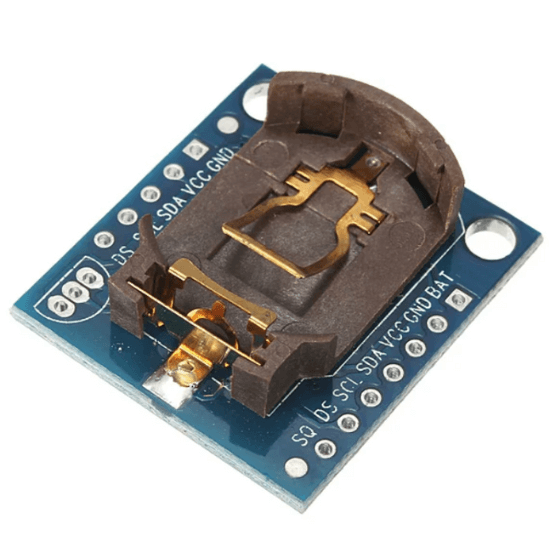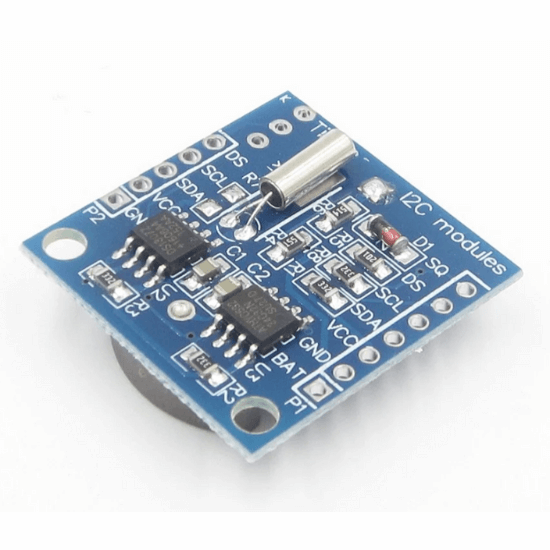Real Time Clock RTC DS1307 Module AT24C32 without Battery Standard Quality
In stock
- Two-wire I2C interface.
- Hour: Minutes: Seconds AM/PM.
- Day Month, Date – Year.
- DS1307-based RTC (Battery not include).
- 1Hz output pin.
- Available in 8-pin DIP or SOIC
₹72.00 ₹149.00 (Price Excl. GST) ₹61.02
In stock
CompareWhat are Real-Time Clocks RTC DS1307?
Real-time clocks (RTC), as the name recommends are clock modules. The RTC DS1307 real-time clock (RTC) IC is an 8-pin device using an I2C interface. The DS1307 is a low-power clock/calendar with 56 bytes of battery backup SRAM. The clock/calendar provides seconds, minutes, hours, day, date, month, and year-qualified data. The end date of each month is automatically adjusted, especially for months with less than 31 days.
They are available as integrated circuits (ICs) and supervise timing like a clock and also operate dates like a calendar. The main advantage of RTC is that they have an arrangement of battery back up which keeps the clock/calendar running even if there is a power failure.
An exceptionally little current is required to keep the RTC animated. We can find these RTCs in many applications like embedded systems, computer motherboards, etc. In this article, we will see one of the real-time clocks RTC DS1307.
Pin Description of RTC DS1307:
Pin 1, 2: Connections for standard 32.768 kHz quartz crystal. The internal oscillator circuitry is intended for operation with a crystal having a specified load capacitance of 12.5pF. X1 is the input to the oscillator and can alternatively be connected to an external 32.768 kHz oscillator. The output of the internal oscillator, X2 is drifted if an external oscillator is connected to X1.
Pin 3: Battery input for any standard 3V lithium cell or another energy source. Battery voltage should be between 2V and 3.5V for suitable operation. The nominal write-protect trip point voltage at which access to the RTC and user RAM is denied is set by the internal circuitry as 1.25 x VBAT nominal. A lithium battery with 48mAhr or greater will back the DS1307 for more than 10 years in the absence of power at 25ºC. UL is recognized to ensure against reverse charging current when utilized as part of conjunction with a lithium battery.
Pin 4: Ground.
Pin 5: Serial data input/output. The input/output for the I2C serial interface is the SDA, which is the open drain and requires a pull-up resistor, allowing a pull-up voltage of 5.5V. Regardless of the voltage on VCC.
Pin 6: Serial clock input. It is the I2C interface clock input and is used in data synchronization.
Pin 7: Square wave/output driver. When enabled, the SQWE bit set to 1, the SQW/OUT pin outputs one of four square-wave frequencies (1Hz, 4 kHz, 8 kHz, and 32 kHz). This is also an open drain and requires an external pull-up resistor. It requires the application of either Vcc or Vb to operate SQW/OUT, with an allowable pull-up voltage of 5.5V, and can be left floating, if not used.
Pin 8: Primary power supply. When the voltage is applied within normal limits, the device is fully accessible and data can be written and read. Read and write are inhibited when a backup supply is connected to the device and VCC is below VTP. However, at low voltages, the timekeeping function still functions.
Features :
- This is the RTC DS1307 Real Time Clock developed by one of our designers.
- Two-wire I2C interface.
- Hour: Minutes: Seconds AM/PM.
- Day Month, Date – Year.
- DS1307 based RTC with LIR2032 battery (Battery include).
- 1Hz output pin.
- Consumes less than 500nA in battery backup mode with oscillator running
- Available in 8-pin DIP or SOIC
- Underwriters Laboratory (UL) recognized
- Real-time clock (RTC) counts seconds, minutes, hours, date of the month, month, day of the week, and year with leap-year compensation valid up to 2100
- 56-byte non-volatile RAM for data storage
- 56 Bytes of Non-volatile memory available to the user.
- The DS1307 is accessed via the I2C protocol.
- The module comes fully assembled and pre-programmed with the current time.
Package Includes :
1 x RTC DS1307 24C32 Real-Time Clock Module
Specifications
| Battery | IR2032 |
|---|---|
| PCB Size ( L x W ) mm | 28 x 28 |
| Weight (gm) | 6 |
| Shipping Weight | 0.01 kg |
| Shipping Dimensions | 6 × 6 × 2 cm |
Shipping & Returns
Due to the type of products we sell, we accept limited returns. Below are the conditions where we can accept a return request.
MANUFACTURING DEFECT
If you receive a product with a manufacturing defect, please notify us within 1 day of receiving the product, supported by the proper pictures and description. Once our support team accept the return, we will provide a replacement or a complete refund including the return shipping cost.
WRONG ITEM SHIPPED
If you receive a different product than the ordered one, please contact us within 1 day of receiving the product, supported by the proper pictures and description. Once our support team accept the return, we will provide a replacement or a complete refund including the return shipping cost.
LIMITATION OF RETURNS
We don’t accept returns for products damaged by improper use of the product. Moreover, we don’t accept the return if the ordered product is unsuitable for any specific application. Please read the product specifications and datasheet before selecting and ordering a product.
WHAT VOID WARRANTY?
If the product is subject to misuse, tampering, static discharge, accident, water or fire damage, use of chemicals & soldered or altered in any way.
SHIPPING
We ship all over India. Please contact our support team at info@inventkart.com for any questions related to shipping.
Based on 0 reviews
Be the first to review “Real Time Clock RTC DS1307 Module AT24C32 without Battery Standard Quality”
You must be logged in to post a review.









There are no reviews yet.